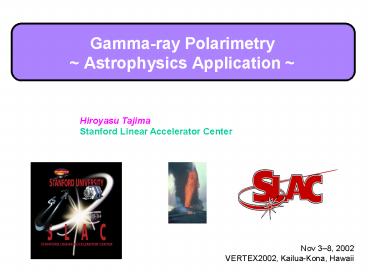Gammaray Polarimetry Astrophysics Application - PowerPoint PPT Presentation
Title:
Gammaray Polarimetry Astrophysics Application
Description:
Gammaray Polarimetry Astrophysics Application – PowerPoint PPT presentation
Number of Views:74
Avg rating:3.0/5.0
Title: Gammaray Polarimetry Astrophysics Application
1
Gamma-ray Polarimetry Astrophysics Application
2
Outline
- Introduction.
- Concepts.
- Key features (requirements.)
- Instrument description.
- Silicon Strip Detector System.
- Double-sided SSD.
- Low noise front-end VLSI.
- Results.
- Noise performance.
- Energy resolution.
- Conclusions and future prospects.
3
Polarization in Astrophysics
- Gamma-ray is excellent probe to study particle
acceleration mechanism in BHs and pulsars. - Polarization is important parameter to understand
gamma-ray production mechanism. - Inverse Compton Scattering.
- Polarization depends on scattering angle.
- Geometrical information.
- Synchrotron Radiation.
- Polarization is perpendicular to magnetic field
direction.
4
Soft Gamma-ray (X-ray) Imaging
X-ray mirror
Well-type Phoswich
Compton telescope
Coded mask
5
Polarization Measurement
- Photoelectric absorption
- Compton Scattering
- Polarization depends on scattering angle, photon
energy.
Eg
Polarization vector
Eg
6
Polarimetry with Micro Pattern Gas Detectors
R. Bellazzini, INFN Pisa
7
Analyzing Power
5.9 keV unpolarized
5.4 keV polarized
Cmax
Cmin
Analyzing power (Cmax- Cmax)/(Cmax Cmax)
50
8
Multiple Compton Technique
Proposed by T. Kamae et al. 1987
9
Key Features (Requirements)
- High energy resolution 1 keV (FWHM).
- High angular resolution 1o (FWHM).
- High background rejection.
- Constraints from Compton kinematics
- Polarimetry.
- Large Field-of-View gt 2 sr.
- Wide energy band 0.0520 MeV.
- Low weight.
- No heavy calorimeter.
120 e (RMS)
10
Angular Resolution
Doppler broadening will limit ultimate angular
resolution.
11
Source Localization
12
With 10X Better Resolution
13
Semiconductor Multiple-Compton Telescope
Si Detector
Doppler broadening is much smaller in Si.
CdTe Detector
photo- absorption
Si
Compton Scattering
pair- creation
CdTe
14
Collaboration
Hiroyasu Tajima, T. Kamae Stanford Linear
Accelerator Center T. Takahashi, K.
Nakazawa Institute of Space and Astronautical
Science Y. Fukazawa Hiroshima University M.
Nomachi Osaka University
15
Performance
- Si is essential for wide energy band.
25cm
80 layers
80 layers of0.5 mm thick Si and CdTe
Si Si
Si CdTe
CdTe CdTe
Takahashi (ISAS)
16
Compton Kinematics
- Background suppression
EGS4.4 MC
17
Polarization Sensitivity
EGS4.4 MC
100 polarized, 100 keV cosq lt 0.6 Analyzing
power 75
18
Recent Development of CdTe Detector
- Tremendous amount of progress has been made.
- Highly uniform, fully active sensors can be
produced.
19
CdTe Gamma-ray Imager
Takahashi (ISAS)
20
Si Strip Detector System
- Why Double-sided Si Strip Detector?
- No self-trigger for CCD.
- Hybrid-pixel detector increases non-active
material. - Monolithic-pixel detector cannot be produced in
large volume. - System configuration.
Front-end VLSI VA32TA
Double-sided Si Strip Detector
R
V
RC chip
21
Double-sided Si Strip Detector
- 2.56cm x 2.56 cm
- 1/2 length of full size sensor.
- 300 µm thick, 400 µm pitch, 100 µm gap.
- Strip capacitance 5.5 pF (measured.)
Junction side
Ohmic side
22
VA32TA Low Noise Front-end VLSI
- Low noise
- Front-end MOSFET geometry optimized for small
capacitance load in 1.2 µm process. - Internal DAC (4-bit trim DAC, bias).
- Fabricated in AMS 0.35 µm process
- Radiation hard to 20 MRad.
- SEU (single event upset) tolerant.
Ideas ASA
23
Prototype System
- AC configuration
- DC configuration
RC chip
VA32TA
Singled-sided SSD
24
Noise Analysis
- Amplifier noise capacitance load.
- Shot noise leakage current.
- Thermal noise detector bias resistance.
120 e (RMS)
25
Noise Performance Summary
26
241Am Spectrum
DC configuration, 0 oC
27
241Am Fit
28
57Co Spectrum
Compton edge
DC configuration, 0 oC
29
57Co Fit
30
Energy Resolution Summary
31
Conclusions and Future Prospects
- Energy resolution measured using prototypes.
- 1.3 keV _at_0 oC for 60 and 122 keV X-rays.
- Noise sources are well understood.
- Imaging test with stacked DSSD prototypes.
- Polarization measurements.
- Further improvements are required for larger
full-sized sensors. - Optimization of front-end MOSFET in 0.35 µm
process. - Reduction of detector capacitance.
- Sensor thickness 300 µm 400 µm.
- Pitch adapter.
32
Sensitivity Gap
- No approved mission to cover 0.120 MeV energy
band. - Sensitivity is mostly limited by BG.
COMPTEL
OSSE
EGRET
Sensitivity (MeV/cm2/s)
33
Liquid Xenon TPC
LXeGRIT collaboration
34
Germanium Compton Telescope
35
(No Transcript)

